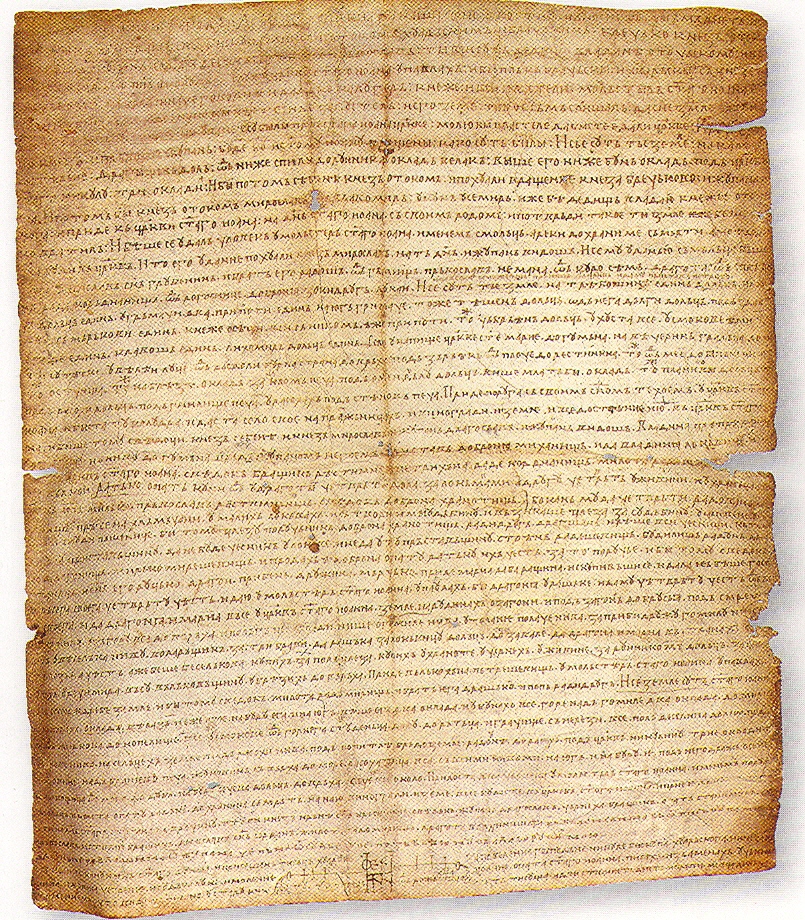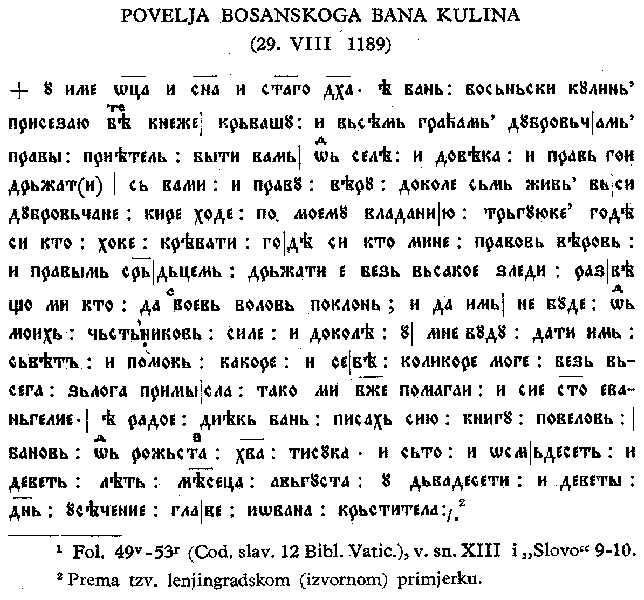|
Bosnian Cyrillic
Bosnian Cyrillic, widely known as Bosančica is a variant of the Cyrillic alphabet that originated in medieval Bosnia. The term was coined at the end of the 19th century by Ćiro Truhelka. It was widely used in modern-day Bosnia and Herzegovina and the bordering areas of modern-day Croatia (southern and middle Dalmatia and Dubrovnik regions). Its name in Bosnian-Croatian-Serbian is ''Bosančica'' and ''Bosanica'' the latter of which can be translated as ''Bosnian script''. Serb scholars call it ''Serbian script'', ''Serbian–Bosnian script'', ''Bosnian–Serb Cyrillic'', as part of variant of Serbian Cyrillic and the term "bosančica" according to them is Austro-Hungarian propaganda. Croat scholars also call it ''Croatian script'', ''Croatian–Bosnian script'', ''Bosnian–Croat Cyrillic'', ''harvacko pismo'', ''arvatica'' or ''Western Cyrillic''. For other names of Bosnian Cyrillic, see below. The use of Bosančica amongst Bosnians was replaced by Arebica upon the introducti ... [...More Info...] [...Related Items...] OR: [Wikipedia] [Google] [Baidu] |
Cyrillic Script
The Cyrillic script ( ), Slavonic script or the Slavic script, is a writing system used for various languages across Eurasia. It is the designated national script in various Slavic languages, Slavic, Turkic languages, Turkic, Mongolic languages, Mongolic, Uralic languages, Uralic, Caucasian languages, Caucasian and Iranian languages, Iranic-speaking countries in Southeastern Europe, Eastern Europe, the Caucasus, Central Asia, North Asia, and East Asia. , around 250 million people in Eurasia use Cyrillic as the official script for their national languages, with Russia accounting for about half of them. With the accession of Bulgaria to the European Union on 1 January 2007, Cyrillic became the third official script of the European Union, following the Latin script, Latin and Greek alphabet, Greek alphabets. The Early Cyrillic alphabet was developed during the 9th century AD at the Preslav Literary School in the First Bulgarian Empire during the reign of tsar Simeon I of Bulgar ... [...More Info...] [...Related Items...] OR: [Wikipedia] [Google] [Baidu] |
Frančesko Micalović
Frančesko Ratkov Micalović was an early 16th-century Ragusan printer who printed the first books on vernacular language of population of contemporary Ragusa (modern-day Dubrovnik). Micalović prepared Cyrillic script types and organized printing of prayer books in Venice in 1512. These prayer books are known as ''Molitvenik'' and ''Officio''. Micalović was obliged to collect printed books and to sell them in his shop which he was to open in Dubrovnik and in Ottoman Serbia. In 1510 and 1513 documents signed by Micalović, the prayer book was referred to as "in the Serbian language and letters". In sources the language of these prayer books and script in which it is printed is referred to as Bosnian, Ragusan, Serbian, Croatian, or Serbo-Croatian, depending on the point of view of its authors, and the Cyrillic script used to print them is in sources referred to as Bosančica. Family Frančesko Micalović's birth name was Ivan or Jovan. His grandfather was a book trader. Franče ... [...More Info...] [...Related Items...] OR: [Wikipedia] [Google] [Baidu] |
Kvarner Gulf
The Kvarner Gulf (, or , la, Sinus Flanaticus or ), sometimes also Kvarner Bay, is a bay in the northern Adriatic Sea, located between the Istrian peninsula and the northern Croatian Littoral mainland. The bay is a part of Croatia's internal waters. The largest islands within the Kvarner are Cres, Krk, Pag, Rab and Lošinj. A portion of the Kvarner Bay, located between Cres, Krk, Rab and Pag is also called ''Kvarnerić'' (literally "little Kvarner") or or , and the portion east of Krk and Rab is called Senj Channel. The bay is notable for its depth (more than 100 meters), which allows for the city of Rijeka at its northernmost point to have a sea port that can accommodate Capesize ships. The bay is also home to many beaches and tourist locations because of its beautiful waters and warm climate. See also * Geography of Croatia The geography of Croatia is defined by its location—it is described as a part of Central Europe and Southeast Europe, a part of the Balkans an ... [...More Info...] [...Related Items...] OR: [Wikipedia] [Google] [Baidu] |
Istria
Istria ( ; Croatian language, Croatian and Slovene language, Slovene: ; ist, Eîstria; Istro-Romanian language, Istro-Romanian, Italian language, Italian and Venetian language, Venetian: ; formerly in Latin and in Ancient Greek) is the largest peninsula within the Adriatic Sea. The peninsula is located at the head of the Adriatic between the Gulf of Trieste and the Kvarner Gulf. It is shared by three countries: Croatia, Slovenia, and Italy.Marcel Cornis-Pope, John Neubauer''History of the literary cultures of East-Central Europe: junctures and disjunctures in the 19th And 20th Centuries'' John Benjamins Publishing Co. (2006), Alan John Day, Roger East, Richard Thomas''A political and economic dictionary of Eastern Europe'' Routledge, 1sr ed. (2002), Croatia encapsulates most of the Istrian peninsula with its Istria County. Geography The geographical features of Istria include the Učka/Monte Maggiore mountain range, which is the highest portion of the Ćićarija/Cicceria ... [...More Info...] [...Related Items...] OR: [Wikipedia] [Google] [Baidu] |
Monastery Of Saint Peter In The Forest
A monastery is a building or complex of buildings comprising the domestic quarters and workplaces of monastics, monks or nuns, whether living in communities or alone (hermits). A monastery generally includes a place reserved for prayer which may be a chapel, church, or temple, and may also serve as an oratory, or in the case of communities anything from a single building housing only one senior and two or three junior monks or nuns, to vast complexes and estates housing tens or hundreds. A monastery complex typically comprises a number of buildings which include a church, dormitory, cloister, refectory, library, balneary and infirmary, and outlying granges. Depending on the location, the monastic order and the occupation of its inhabitants, the complex may also include a wide range of buildings that facilitate self-sufficiency and service to the community. These may include a hospice, a school, and a range of agricultural and manufacturing buildings such as a barn, a forge, o ... [...More Info...] [...Related Items...] OR: [Wikipedia] [Google] [Baidu] |
Poljica Statute
The Poljica Statute is the most important historical source for the Republic of Poljica. The statute determined the law of Poljica, which is, by its form, style, content and establishment of social-economic relations, totally different from the rest of Croatian statutes. It is written in short, picturesque sentences that include the norms of Poljica's society from those regarding the highest political authorities to those that include all Poljicians' interests. Besides the laws written in this statute, the Poljica Statute also contains various decisions and verdicts of authority that, in a few occasions, refer to individuals. The Poljica Statute was changed as the society of Poljica changed. Another important value of the Poljica Statute is its archaic form, which can be used to study the people from Poljica and those from Croatia in general at the time it was formulated. Typical features of the Poljica Statute are guarantees of freedom but also acceptance of responsibility to pr ... [...More Info...] [...Related Items...] OR: [Wikipedia] [Google] [Baidu] |
Bosnia And Herzegovina
Bosnia and Herzegovina ( sh, / , ), abbreviated BiH () or B&H, sometimes called Bosnia–Herzegovina and often known informally as Bosnia, is a country at the crossroads of south and southeast Europe, located in the Balkans. Bosnia and Herzegovina borders Serbia to the east, Montenegro to the southeast, and Croatia to the north and southwest. In the south it has a narrow coast on the Adriatic Sea within the Mediterranean, which is about long and surrounds the town of Neum. Bosnia, which is the inland region of the country, has a moderate continental climate with hot summers and cold, snowy winters. In the central and eastern regions of the country, the geography is mountainous, in the northwest it is moderately hilly, and in the northeast it is predominantly flat. Herzegovina, which is the smaller, southern region of the country, has a Mediterranean climate and is mostly mountainous. Sarajevo is the capital and the largest city of the country followed by Banja Luka, Tu ... [...More Info...] [...Related Items...] OR: [Wikipedia] [Google] [Baidu] |
Charter Of Ban Kulin
The Charter of Ban Kulin ( Bosnian-Serbian-Croatian: Povelja Kulina bana / Повеља Кулина бана) was a trade agreement between the Banate of Bosnia and the Republic of Ragusa that effectively regulated Ragusan trade rights in Bosnia, written on 29 August 1189. It is one of the oldest written state documents in the region. According to the charter, Bosnian Ban Kulin promises to '' knez'' Krvaš and all the people of Dubrovnik full freedom of movement and trading across his country. The charter is written in two languages: Latin and an old form of Shtokavian dialect, with the Shtokavian part being a loose translation of the Latin original. The scribe was named as Radoje, and the script is Bosnian Cyrillic (''Bosančica''). Language The Charter is the first diplomatic document written in the old Bosnian language and represents the oldest work written in the Bosnian Cyrillic Bosnian Cyrillic, widely known as Bosančica is a variant of the Cyrillic alphabet that origi ... [...More Info...] [...Related Items...] OR: [Wikipedia] [Google] [Baidu] |
Republic Of Ragusa
hr, Sloboda se ne prodaje za sve zlato svijeta it, La libertà non si vende nemmeno per tutto l'oro del mondo"Liberty is not sold for all the gold in the world" , population_estimate = 90 000 in the XVI Century , currency = Ragusa perpera and others , common_languages = , title_leader = Rector as Head of state , leader1 = Nikša Sorgo , year_leader1 = 1358 , leader2 = Sabo Giorgi , year_leader2 = 1807-1808 , today = Croatia Bosnia and Herzegovina Montenegro , footnotes = A Romance language similar to both Italian and Romanian. While present in the region even before the establishment of the Republic, Croatian, also referred to as ''Slavic'' or ''Illyrian'' at the time, had not become widely spoken until late 15th century. The Republic of Ragusa ( dlm, Republica de Ragusa; la, Respublica Ragusina; it, Repubblica di Ragusa; hr, Dubrovačka Republika ... [...More Info...] [...Related Items...] OR: [Wikipedia] [Google] [Baidu] |
Bosnian Church
The Bosnian Church ( sh-Latn-Cyrl, separator=/, Crkva bosanska, Црква Босанска) was a Christian church in medieval Bosnia and Herzegovina that was independent of and considered heretical by both the Catholic and the Eastern Orthodox hierarchies. Historians traditionally connected the church with the Bogomils, although this has been challenged and is now rejected by the majority of scholars. Adherents of the church called themselves simply ''Krstjani'' ("Christians") or ''Dobri Bošnjani, Usorani, Humljani...'' ("Good Bosnians, Usorans, Humlians..."). The church's organization and beliefs are poorly understood, because few if any records were left by church members and the church is mostly known from the writings of outside sources - primarily Catholic ones. The monumental tombstones called '' stećak'' that appeared in medieval Bosnia, as well as Croatia, Serbia, and Montenegro, are sometimes identified with the Bosnian Church. Background Schism Christian missions ... [...More Info...] [...Related Items...] OR: [Wikipedia] [Google] [Baidu] |
Bible
The Bible (from Koine Greek , , 'the books') is a collection of religious texts or scriptures that are held to be sacred in Christianity, Judaism, Samaritanism, and many other religions. The Bible is an anthologya compilation of texts of a variety of forms originally written in Hebrew, Aramaic, and Koine Greek. These texts include instructions, stories, poetry, and prophecies, among other genres. The collection of materials that are accepted as part of the Bible by a particular religious tradition or community is called a biblical canon. Believers in the Bible generally consider it to be a product of divine inspiration, but the way they understand what that means and interpret the text can vary. The religious texts were compiled by different religious communities into various official collections. The earliest contained the first five books of the Bible. It is called the Torah in Hebrew and the Pentateuch (meaning ''five books'') in Greek; the second oldest part was a coll ... [...More Info...] [...Related Items...] OR: [Wikipedia] [Google] [Baidu] |





.jpg)

.jpg)